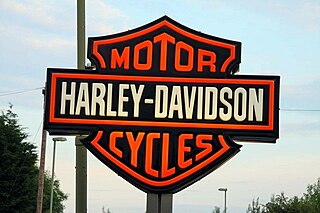
Harley-Davidson, Inc. is an American motorcycle manufacturer headquartered in Milwaukee, Wisconsin, United States. Founded in 1903, it is one of two major American motorcycle manufacturers to survive the Great Depression along with its historical rival, Indian Motorcycles. The company has survived numerous ownership arrangements, subsidiary arrangements, periods of poor economic health and product quality, and intense global competition to become one of the world's largest motorcycle manufacturers and an iconic brand widely known for its loyal following. There are owner clubs and events worldwide, as well as a company-sponsored, brand-focused museum.

Orange County Choppers (OCC) was an American motorcycle manufacturer and lifestyle brand company based in the town of Newburgh, located in Orange County, New York, that was founded in 1999 by Paul Teutul Sr. The company was featured on American Chopper, a reality TV show that debuted in September 2002 on the Discovery Channel. The series moved to Discovery Channel's sister channel TLC in 2007. Following cancellation of the Discovery series, the company was also featured on Orange County Choppers on the CMT network in 2013. Orange County Choppers returned to Discovery Channel in March 2018.

A chopper is a type of custom motorcycle which emerged in the US state of California in the late 1950s. A chopper employs modified steering angles and lengthened forks for a stretched-out appearance. They can be built from an original motorcycle which is modified ("chopped") or built from scratch. Some of the characteristic features of choppers are long front ends with extended forks often coupled with an increased rake angle, hardtail frames, very tall "ape hanger" or very short "drag" handlebars, lengthened or stretched frames, and larger than stock front wheel. To be considered a chopper a motorcycle frame must be cut and welded at some point. I.e. the name chopper. The "sissy bar", a set of tubes that connect the rear fender with the frame, and which are often extended several feet high, is a signature feature on many choppers.

A custom motorcycle is a motorcycle with stylistic and/or structural changes to the 'standard' mass-produced machine offered by major manufacturers. Custom motorcycles might be unique, or built in limited quantities. While individual motorcyclists have altered the appearance of their machines since the first days of motorcycling, the first individualized motorcycles specifically labeled 'Custom' appeared in the late 1950s, around the same time as the term was applied to custom cars.

A softail motorcycle intentionally looks like vintage motorcycles with a rigid hard-tail frame that has a triangle of steel tubes at the rear axle, as on a bicycle frame, but on a Softail these tubes are actually a triangular swingarm, with the shock absorber(s) hidden, as opposed to clearly visible regular twin shocks on both sides of the rear wheel on standard bikes. Since the introduction of the Harley-Davidson FXST Softail in 1983 as a registered trademark of the Motor Company, softail has become a genericized trademark for other models of cruiser motorcycles with rear suspensions hidden for retro style reasons. This was done even though the rear wheel was often hidden behind bags or exhaust pipes.

A streetfighter, muscle bike, or supernaked is a type of high-performance motorcycle. It is typically a large-displacement sport bike with the fairings and windscreen removed. Beyond simply removing fairings, specific changes that exemplify the streetfighter look are a pair of large, round headlights, tall, upright handlebars such as those on a motocross bike, and short, loud, lightweight mufflers, and changes in the sprockets to increase torque and acceleration at lower speeds. Streetfighters is also the name of a UK motorcycle magazine.

In the market, there is a wide variety of types of motorcycles, each with unique characteristics and features. Models vary according to the specific needs of each user, such as standard, cruiser, touring, sports, off-road, dual-purpose, scooters, etc. Often, some types like sport touring are considered as an additional category or integrated with touring.

The Harley-Davidson Sportster is a line of motorcycles produced continuously since 1957 by Harley-Davidson. Sportster models are designated in Harley-Davidson's product code by beginning with "XL". In 1952, the predecessors to the Sportster, the Model K Sport and Sport Solo motorcycles, were introduced. These models K, KK, KH, and KHK of 1952 to 1956 had a sidevalve engine, whereas the later XL Sportster models use an overhead valve engine. The first Sportster in 1957 had many of the same features of the KH including the frame, fenders, large gas tank and front suspension.
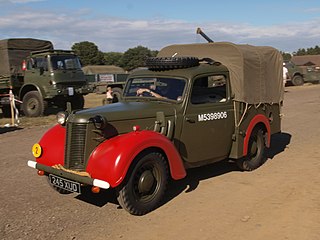
Fender is the American English term for the part of an automobile, motorcycle or other vehicle body that frames a wheel well. Its primary purpose is to prevent sand, mud, rocks, liquids, and other road spray from being thrown into the air by the rotating tire. Fenders are typically rigid and can be damaged by contact with the road surface.
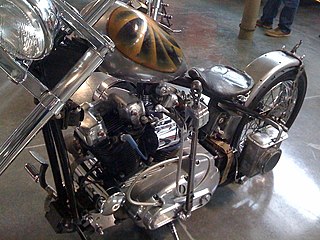
The terms suicide clutch, and suicide shifter or jockey shifter, refer to some motorcycles' foot-operated clutch and hand shifter to change gears. Foot clutches (rocker-clutches) and hand shifters (tank-shifts) were found on early motorcycle designs from around the turn of the 20th century to the 1940s or 50s, and reappearing on modern retro styled custom motorcycles and choppers. Modern motorcycles do not require removing a hand from the handlebars to shift gears, using only the fingers for the clutch and the toes of one foot to select gears. In contrast, the fanciful slang "suicide" was applied to designs where the rider removes one hand to change gears, or cannot put both feet on the ground while using a foot clutch to disengage the transmission. Sometimes the shifter is referred to as a "jockey shifter" while the foot clutch is called a "suicide clutch".

A touring motorcycle is a type of motorcycle designed for touring. Although almost any motorcycle can be used for this purpose, manufacturers have developed specific models designed to address the particular needs of these riders. Touring motorcycles commonly have large displacement fairings and windshields that offer a high degree of weather and wind protection, large-capacity fuel tanks for long ranges between fill-ups, engines with a great deal of low-end horsepower, and a more relaxed, upright seating position than sport bikes.

A cruiser motorcycle is a motorcycle in the style of American machines from the 1930s to the early 1960s, including those made by Harley-Davidson, Indian, Excelsior and Henderson.
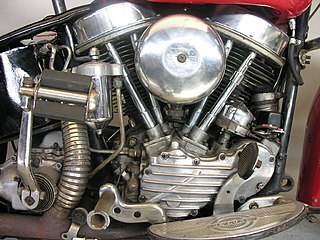
Harley-Davidson FL is a model designation used for Harley-Davidson motorcycles since 1941, when F referred to the new large capacity 74 cui (1200cc) variant of the V-2 Overhead valve engine (″Knucklehead″) that was introduced in 1936 as Model E with 61 cui (1000cc). The presence of an additional letter L indicated higher compression, offering more power but requiring higher octane gasoline. In 1950s, the low compression version was discontinued, and in 1952 also the low capacity EL, making FL the standard engine and model designation for decades to come.
The Harley-Davidson Super Glide was a motorcycle made by the Harley-Davidson. Reputed to be the first factory custom motorcycle, it originated Harley-Davidson's FX series of motorcycles by mating Sportster components, most notably the front end, with the chassis of their larger big twin motorcycles. Super Glide models from 1991 to 2018 were based on the Dyna Glide chassis which has a wider variety of front ends and trim levels, and for a time filled the intermediate niche between the smallest and largest Harley-Davidson models; the Dyna platform has since been discontinued for the 2018 model year in favor of the new Softail frame, with some models from the Dyna nameplate being carried over to the Softail line.
Big Dog Motorcycles is a manufacturer of semi-custom, mid-priced motorcycles, based in Wichita, Kansas, United States. The company was founded in 1994, shut down in 2011, and recently reopened as Big Dog Is Back.
Orange County Choppers bikes are motorcycles featured on the television series American Chopper built by Orange County Choppers (OCC) for a specific corporate or celebrity customer. Theme bikes are motorcycles in which the theme of the motorcycle takes priority over everything else, influencing the frame dimensions, paint scheme, and overall 'feel' of the motorcycle. The function of motorcycle usually takes a backseat to the presentation of the theme, and these motorcycles attract attention solely on the premise of the theme itself. Customer bikes are built for and generally to the specifications of a particular customer. Although the customers typically give OCC creative freedom to do what they will, some clients have a specific idea in mind and expect OCC to reproduce their mental picture literally.
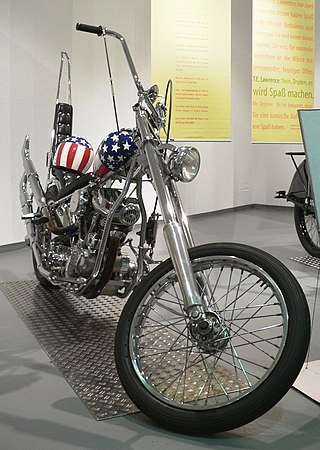
Benjamin F. Hardy (1921-1994) was an American custom motorcycle builder who made the Captain America and Billy choppers for the 1969 Peter Fonda road movie Easy Rider.

The Harley-Davidson XR-750 is a racing motorcycle made by Harley-Davidson since 1970, primarily for dirt track racing, but also for road racing in the XRTT variant. The XR-750 was designed in response to a 1969 change in AMA Grand National Championship rules that leveled the playing field for makes other than Harley-Davidson, allowing Japanese and British motorcycles to outperform the previously dominant Harley-Davidson KR race bike. The XR-750 went on to win the most races in the history of American Motorcyclist Association (AMA) racing.

The following outline is provided as an overview of motorcycles and motorcycling:

The Harley-Davidson XLCR was an American café racer motorcycle manufactured by Harley-Davidson between 1977 and 1979.


















